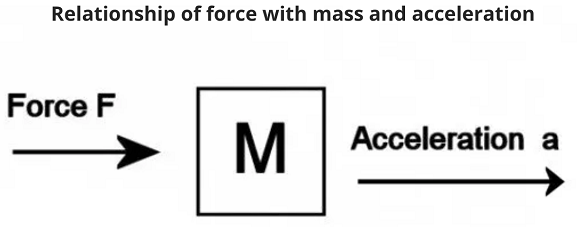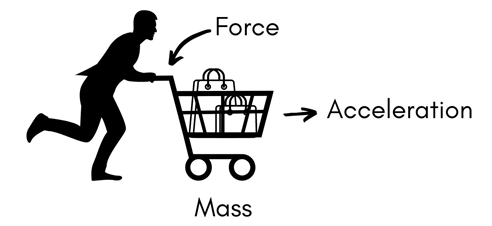
Zayn and Liam are trying to push two different tables, both of different sizes. Zayn is stronger than Liam and is applying more force. So, will he succeed in moving the table?
Not necessarily! This depends on the size of the tables they are pushing. Similarly, if the tables were of the same size and only the forces were different, the acceleration with which the tables would have moved would be different.
This is because force, mass, and acceleration are interrelated. This relation can be explained through Newton’s second law of motion.
But before that, let’s first have a look at the definitions and properties of mass, acceleration, and force.
Table of Contents
What is a Force?
A simple definition of force is-
An influence on a body that causes it to change its existing state.
Force is a vector quantity and exists in different forms e.g gravitational, friction, magnetic, impact e.t.c.
Sometimes forces don’t change the state but the physical form of an object.
The SI unit of force is Newton. One newton is equal to a kilogram meter per second square.
What is an Acceleration?
Acceleration can be defined as
Acceleration is the rate of change of the velocity with respect to time.
Acceleration is also a vector quantity. And its direction comes precisely from the direction of the force.
It can be positive and negative depending on the nature of change.
Acceleration is derived from velocity. Its SI unit is meter per second per second (m/s2).
What is a Mass?
The mass of a body accounts for the physical matter a body contains.
Mass is an intrinsic property. It is commonly measured in Kilograms which is also its SI unit. Other units include pounds, atomic mass unit etc.
Mass does not specifically make up the size of a body.
A tennis ball and a lead ball of the same size will have different mass. It means mass is a natural property and cannot be altered without deforming the object.
What is a difference between weight and mass?
Mass and Weight are often considered the same thing. But they are different. Weight can differ from place to place due to the gravitational force.
Relationship between Force, Mass, and Acceleration
Issac Newton, in his book ‘Principia Mathematica’ along with other studies, gave three laws of motion.
The second law of newton explains the relationship between force, mass, and acceleration.
It states that:
The acceleration of an object is dependent upon two variables- the net force acting upon the object and the mass of the object.
This is written in mathematical form as:
Acceleration, (A) = (Force / Mass) (Unit- m/s2)
This can be rearranged as:
Force, (F) = (Acceleration * Mass) (Unit- N)
According to this law, force is directly proportional to the mass and acceleration of a body.
If mass increases, the force will also increase and vice versa. Similarly, a change in acceleration directly affects the force.

Relation between Force and Acceleration
Force is a vector quantity, having both magnitude and direction. Acceleration and force have the same direction.
When a force is applied to a body in a forwarding direction, positive acceleration is produced in the same direction.
Along with direction, acceleration and force also affect the magnitude of each other. Small force means less acceleration and bigger force means more acceleration.
Force (F) ∝ Acceleration (A)
Relation between Force and Mass
Keeping in view Newton’s second law, we know force and mass are directly related.
A mass of 10 kilograms requires more force to make it in comparison to a mass of 5 kilograms.
Force (F) ∝ Mass (M)
Understanding the relation through Example:
At the start of the article, you read an example. Let’s use it again but this time we will assume some magnitudes as well.
- For force and acceleration, keeping mass constant
Zayn is pushing a table of mass 50kg with a force of 20N. Liam is also pushing a table of 50kg but with a force of 15N.
It’s common sense that Zyan’s table will have more acceleration than Liam’s. But let’s prove it through calculations.
For Zyan, Mass= 50kg and Force= 20N
Force= (Mass * Acceleration)
By putting the given value,
Acceleration= (Force / Mass)= (20 / 50)= 0.4m/s2
For Liam, Mass= 50kg and Force= 15N
Force= (Mass * Acceleration)
By putting the given value,
Acceleration= (Force / Mass)= (15 / 50)= 0.3m/s2
From the calculation above, it is obvious how a change in force affects acceleration.
- Force and mass, keeping acceleration constant:
For the second example, Zayn is pushing at a rate of 0.2m/s2 a table of 40kg with some force. And Liam is pushing at a rate of 0.2m/s2 table of 50kg with some force. Calculate the force.
For Zyan, Mass= 50kg and Acceleration= 0.2m/s2
Force= (Mass * Acceleration)
By putting the given value,
Force (F)= (50*0.2)= 10N
For Zyan, Mass= 40kg and Acceleration= 0.2m/s2
Force= (Mass * Acceleration)
By putting the given value,
Force (F)= (40*0.2)= 8N
Observing the examples of Newton’s second law of motion, you can see that force is directly affected by mass. Understanding through a table:
In the previous heading, the relationship of force is explained in detail with mass and acceleration. But to clear any further confusion, let’s learn it through a table.
| Changing factor | Mass (M) | Acceleration (A) | Force (F = M*A) |
| Mass | 2kg | 5m/s2 | 10N |
| Mass | 4kg | 5m/s2 | 20N |
| Acceleration | 2kg | 3m/s2 | 6N |
| Acceleration | 2kg | 6m/s2 | 12N |
This table also explains how a change in mass only, affects force. Similarly, it also proves the direct relationship of acceleration with force.
Calculating force by manually and online
Wondering how to calculate force? Below is the answer. You can calculate force both manually and online.
Manually:
Calculating force is quite easy. Just follow these steps:
- Change mass and acceleration into SI units.
- Multiply mass with acceleration
- Here you have the answer.
Online:
There are math and physics calculators available online for quick calculations. For force, you can use the magnitude of force calculator.

Force Calculator
[CP_CALCULATED_FIELDS id=”73″]
Acceleration Calculator
[CP_CALCULATED_FIELDS id=”75″]
Mass Calculator
[CP_CALCULATED_FIELDS id=”74″]
These calculators only calculate magnitude, as the name tells. As said before, the direction of force and acceleration is the same.
Conclusion:
To sum it all up in one line, force is directly related to mass and acceleration.